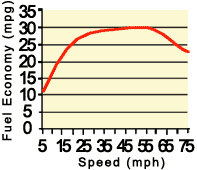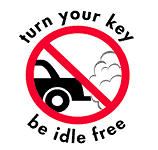| |
Transportation and Vehicle Fuel Conservation
Revised: October 5, 2010
Transportation makes up 28% of all energy usage - U.S. Department of Energy

The transportation sector includes all vehicles used for personal or freight transportation. Of the energy used in this sector, approximately 65% is consumed by gasoline-powered vehicles, primarily personally owned. The two oil supply crisis of the 1970s spurred the creation, in 1975, of the federal Corporate Average Fuel Economy (CAFE) program, which required auto manufacturers to meet progressively higher fleet fuel economy targets. The next decade saw dramatic improvements in fuel economy, mostly the result of reductions in vehicle size and weight which originated in the late 1970s, along with the transition to front wheel drive. These gains eroded somewhat after 1990 due to the growing popularity of sport utility vehicles, pickup trucks and minivans, which fall under the more lenient "light truck" CAFE standard.
Burning fossil fuels such as gasoline and diesel adds greenhouse gases, mostly carbon dioxide (CO2), to the Earth’s atmosphere. Vehicles with lower fuel economy burn more fuel, creating more CO2. Your vehicle creates about 20 pounds of CO2 (170 cu. ft.) per gallon of gasoline it consumes.
Did you know?
The U.S. uses more than 20 million barrels of oil each day
60% of our oil is imported
68% is used for transportation
Oil imports cost us $270 billion annually
Vehicle Efficiency
 Aggressive driving (speeding and rapid acceleration and braking) can lower your gas mileage by as much as 33% at highway speeds and 5% around town.
Observe the speed limit—each 5 MPH you drive over 60 MPH can reduce your fuel economy by 7-8%
Fixing a car that is noticeably out of tune can improve gas mileage by about 4%.
Keeping tires inflated to the correct tire pressure can improve your fuel economy by 5%.
Keep your tires aligned and balanced.
Replacing a clogged air filter can improve gas mileage.
By choosing a vehicle that achieves 25 miles per gallon rather than 20, you can prevent the release of about 17 tons (260,000 cu. ft.) of greenhouse gases over the lifetime of your vehicle. The 2009 Fuel Economy Guide published by the EPA and Department of Energy is available in PDF format and contains mileage per gallon information for hundreds of vehicles for that model year.
Aggressive driving (speeding and rapid acceleration and braking) can lower your gas mileage by as much as 33% at highway speeds and 5% around town.
Observe the speed limit—each 5 MPH you drive over 60 MPH can reduce your fuel economy by 7-8%
Fixing a car that is noticeably out of tune can improve gas mileage by about 4%.
Keeping tires inflated to the correct tire pressure can improve your fuel economy by 5%.
Keep your tires aligned and balanced.
Replacing a clogged air filter can improve gas mileage.
By choosing a vehicle that achieves 25 miles per gallon rather than 20, you can prevent the release of about 17 tons (260,000 cu. ft.) of greenhouse gases over the lifetime of your vehicle. The 2009 Fuel Economy Guide published by the EPA and Department of Energy is available in PDF format and contains mileage per gallon information for hundreds of vehicles for that model year.
Idling: Myths and Suggestions
Vehicle exhaust is one of the leading sources of air pollution in Utah. While sitting in an idling vehicle, drivers are exposed to higher levels of vehicle pollution than when the vehicle is in motion because exhaust enters the cabin. Emissions from vehicles contain Oxides of Nitrogen (NOx) and Volatile Organic Compounds (VOCs) which are prime ingredients in the formation of Ozone and Particulate Matter (PM).  They are a major source of air pollution in Utah. Like driving, idling releases emissions into the air, but unlike driving, idling is unnecessary. As a rule of thumb, if you're in a drive-through at a restaurant, the bank or other business, or waiting for someone and you'll be parked and sitting for 10 seconds or longer, turn off your car's engine. They are a major source of air pollution in Utah. Like driving, idling releases emissions into the air, but unlike driving, idling is unnecessary. As a rule of thumb, if you're in a drive-through at a restaurant, the bank or other business, or waiting for someone and you'll be parked and sitting for 10 seconds or longer, turn off your car's engine.
Misconceptions exist about idling, including the following:
Myth #1: The engine should be warmed up before driving. Reality: Idling is not an effective way to warm up your vehicle, even in cold weather. The best way to do this is to drive the vehicle.
Myth #2: Idling is good for your engine. Reality: Excessive idling can actually damage your engine components, including cylinders, spark plugs, and exhaust systems. Fuel is only partially combusted when idling because an engine does not operate at its peak temperature.
Myth #3: Shutting off and restarting your vehicle is hard on the engine and uses more gas than if you leave it running. Reality: Frequent restarting has little impact on engine components like the battery and the starter motor.. The bottom line is that more than ten seconds of idling uses more fuel than restarting the engine.
Electric Vehicles
Electric vehicles (EVs) are propelled by an electric motor (or motors) powered by rechargeable battery packs.
Energy efficient. Electric motors convert 75% of the chemical energy from the batteries to power the wheels.
Environmentally friendly. EVs emit no tailpipe pollutants, although the power plant producing the electricity may emit them.
Reduce energy dependence. Electricity is a domestic energy source.
Performance benefits. Electric motors provide quiet, smooth operation
Alternative Fuels
Biodiesel: manufactured from vegetable oils or animal fats
Electricity
Ethanol: is primarily produced from starch-based crops
Natural Gas compressed natural gas (CNG) or liquefied natural gas (LNG)
Propane: liquefied petroleum gas (LPG)
|



 They are a major source of air pollution in Utah. Like driving, idling releases emissions into the air, but unlike driving, idling is unnecessary. As a rule of thumb, if you're in a drive-through at a restaurant, the bank or other business, or waiting for someone and you'll be parked and sitting for 10 seconds or longer, turn off your car's engine.
They are a major source of air pollution in Utah. Like driving, idling releases emissions into the air, but unlike driving, idling is unnecessary. As a rule of thumb, if you're in a drive-through at a restaurant, the bank or other business, or waiting for someone and you'll be parked and sitting for 10 seconds or longer, turn off your car's engine.